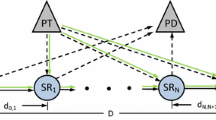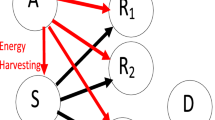Abstract
We consider spectrum-sharing scenario where coexist two communication networks including primary network and secondary network using the same spectrum. While the primary network includes directional multi-transceivers, the secondary network consists of relaying-based transceiver forwarding signals by energy harvesting assisted relay node. In cognitive radio, signals transmitted from secondary network are sufficiently small so that all of primary network receivers have signal to noise ratio (SNR) greater than a given threshold. In contrast, the transmitted signals from primary network cause increasing noise which is difficult to demodulate at secondary network nodes and hence it leads to the peak power constraint. In this paper, we focus on the influence of random location of transceivers at primary network using decode-and-forward protocol. Specifically, we derive closed-form outage probability expression of the secondary network under random location of transceivers and peak power constraint of primary network. This investigation shows the relationship between the fraction of energy harvesting time \(\alpha \) of time switching-based relaying protocol on outage probability of secondary network and throughput. In addition, we analyse the influence of the number of primary network transceivers as well as primary network’s SNR threshold on secondary network. Furthermore, the trade-off between increasing energy harvesting and rate was investigated under the effect of energy conversion efficiency. The accuracy of the expressions is validated via Monte-Carlo simulations. Numerical results highlight the trade-offs associated with the various energy harvesting time allocations as a function of outage performance.








Similar content being viewed by others
References
Do, D.-T. (2015). Energy-aware two-way relaying networks under imperfect hardware: Optimal throughput design and analysis. Telecommunication Systems (Springer), 62(2), 449–459.
Yin, S., Qu, Z., & Li, S. (2015). Achievable throughput optimization in energy harvesting cognitive radio systems. IEEE Journal on Selected Areas in Communications, 33(3), 407–422.
Gu, Y., & Aissa, S. (2014). Interference aided energy harvesting in decode-and-forward relaying systems. In Proc. of IEEE international conference on communications (ICC), Sydney, Australia, June 2014, pp. 5378–5382.
Nasir, A. A., Zhou, X., Durrani, S., & Kennedy, R. A. (2013). Relaying protocols for wireless energy harvesting and information processing. IEEE Transactions on Wireless Communications, 12(7), 3622–3636.
Nasir, A. A., Zhou, X., Durrani, S., & Kennedy, R. A. (2014). Throughput and ergodic capacity of wireless harvesting based DF relaying network. In Proc. of IEEE ICC, Sydney, Australia, June 2014, pp. 4066–4071.
Do, D.-T. (2016). Optimal throughput under time power switching based relaying protocol in energy harvesting cooperative network. Wireless Personal Communications (Springer), 87(2), 551–564.
Wang, Z., Chen, Z., Yao, Y., Xia, B., & Liu, H. (2014). Wireless energy harvesting and information transfer in cognitive two-way networks. In Proc. of IEEE GLOBECOM, Austin, Texas, US, Dec. 2014, pp. 3465–3470.
Liu, Y., Wang, L., Elkashlan, M., Duong, Trung Q., & Nallanathan, A. (2014). Relaying networks with wireless power transfer policies design and throughput analysis. In Proc. of IEEE GLOBECOM, Austin, Texas, US, Dec. 2014, pp. 4030–4035.
Liu, Y., Ali Mousavifar, S., Deng, Y., Leung, Cyril, & Eskashlan, M. (2015). Wireless energy harvesting in a cognitive relay networks’. IEEE Transactions on Wireless Communications, 15(4), 2498–2508.
Yang, Z., Ding, Z., Fan, P., & Karagiannidis, G. K. (2016). Outage performance of cognitive relay networks with wireless information and power transfer. IEEE Transactions on Vehicular Technology, 65(5), 3828–3833.
Liu, L., Zang, R., & Chua, K. C. (2013). Wireless information and power transfer: A dynamic power splitting approach. IEEE Transactions on Communications, 61(9), 3990–4001.
Yang, Z., Fan, P., & Karagiannidis, G. K. (2015). Outage performance of cognitive relay networks with wireless information and power transfer. IEEE Transactions on Vehicular Technology, 65(5), 3828–3833.
Zhou, X., Zhang, R., & Ho, C. K. (2013). Wireless information and power transfer: Architecture design and rate-energy trade-off. IEEE Transactions on Wireless Communications, 61(11), 4754–4767.
Gastpar, M. (2007). On capacity under receive and spatial spectrum-sharing constraints. IEEE Transactions on Information Theory, 53(2), 471–487.
Letaief, K. B., & Zhang, W. (2009). Cooperative communications for cognitive radio networks. Proceedings of the IEEE, 97(5), 878–893.
Simeone, O., Stanojev, l, Savazzi, S., Bar-Ness, Y., Spagnolini, U., & Pickholtz, R. L. (2008). Spectrum leasing to cooperating secondary ad hocnetworks. IEEE Journal Selected Areas Communications, 26(1), 203–213.
Stanojev, L., Simeone, O., Spagnolini, U., Bar-Ness, Y., & Pickholtz, R. L. (2010). Cooperative ARQ via auction-based spectrum leasing. IEEE Transactions on Communications, 58(6), 1843–1856.
Lee, K., Simeone, O., Chae, C. B., & Kang, J. (2011). Spectrum leasing via cooperation for enhanced physical-layer secrecy. In Proc. of IEEE ICC, Kyoto, Japan, June 2011.
Park, S., & Hong, D. (2014). Achievable throughput of energy harvesting cognitive radio networks. IEEE Transactions on Wireless Communications, 13(2), 1010–1022.
Shafie, A., & Sultan, A. (2013). Optimal random access for a cognitive radio terminal with energy harvesting capability. IEEE Wireless Communications Letters, 17(6), 1128–1131.
Park, S., & Hong, D. (2013). Optimal spectrum access for energy harvesting cognitive radio networks. IEEE Transactions on Wireless Communications, 12(12), 6166–6179.
Lee, S., Zhang, R., & Huang, K. (2013). Opportunistic wireless energy harvesting in cognitive radio networks. IEEE Transactions on Wireless Communications, 12(9), 4788–4799.
Papoulis, A., Pillai, S. U. (2002). Probability, Random Variables, and Stochastic Processes. (4th ed.). McGaw-Hill Inc.
Gradshteyn, I. S., & Ryzhik, I. M. (2007). Table of Integrals, Series, and Products. New York, NY: Academic Press.
Rohatgi, V. K. (1976). An introduction to probability theory and mathematical statistics. New York: Wiley.
Author information
Authors and Affiliations
Corresponding author
Appendices
Appendix A: Proof of Proposition 1
Firstly, we can rewrite (9) as below expression
where \(X = \frac{{{P_{S\min }}}}{{{\sigma ^2}}}{\left| {{h_{sr}}} \right| ^2}\), \(Y = \sum _{i = 1}^L {\frac{{{P_T}}}{{{\sigma ^2}}}} {\left| {{h_{pr[i]}}} \right| ^2}\). X is the exponential distributed random variable (ERV) with mean \({\lambda _{sr}} = \frac{{{P_{S\min }}}}{{{\sigma ^2}}}P{L_{sr}}\), Y is the sum of ERVs, in which each part has mean \({\lambda _{pr[i]}} = \frac{{{P_T}}}{{{\sigma ^2}}}P{L_{pr[i]}}\),respectively. By applying Lemma 1, the pdf(Y) and cdf(Y) are proven. Probability of (31) in (10) is solved by separating two cases:
and vice versa.
After reducing (32), we obtain the express as in (15).
Appendix B: Proof of Propostion 2
From (20) we can write:
We need to solve three subcases: (22), (23) and (24). Firstly, substituting the value of \({P_{REH}}\) in (18) to \(\mathfrak {K}\) form in (33), we receive
where \({X_i}\): \(i = 1 \div L\): \(f\left( {{X_i}} \right) = \frac{1}{{{\lambda _{pr[i]}}}}{e^{ - \;\frac{x}{{{\lambda _{pr[i]}}}}}}\), \({X_{L + 1}}\): \(f\left( {{X_{L + 1}}} \right) = \frac{1}{{{\lambda _{sr}}}}{e^{ - \;\frac{x}{{{\lambda _{sr}}}}}}\), \(\hat{w} = \frac{{{P_R}\left( {1 - \alpha } \right) }}{{2\alpha \delta {\sigma ^2}}} - 1\). Applying Lemma 1, we obtain (22).
Secondly, \(\mathfrak {M}\) form in (33) is given by
where
is the sum of ERVs, \(U = \frac{{{P_R}}}{{{\sigma ^2}}}{\left| {{h_{rd}}} \right| ^2}\) is ERV. (36) and (31) have similar in form. Thus, we use the same way to obtain (23).
Finally, \(\mathfrak {N}\) form in (33) is expressed as
Let us denote \(T = \frac{{2\alpha \delta }}{{\left( {1 - \alpha } \right) }}{\left| {{h_{rd}}} \right| ^2}\), \(Z = \left( \frac{{{{\text {P}} _{S\min }}}}{{{\sigma ^2}}}{{\left| {{h_{sr}}} \right| }^2}\right. \left. + \sum \nolimits _{i = 1}^L {\frac{{{P_{PT[i]}}}}{{{\sigma ^2}}}{{\left| {{h_{pr[i]}}} \right| }^2} + \,} 1 \right) \),\({P_{REH}}\) in (18), V in (37) can be substituted, we obtain
Applying Rohatgi’s well-known results in [25] and formula Eq. 3.471.9 in [24], we have PDF of (\( U=TZ \))
where \({\lambda _{^{rdn}}} = P{L_{rd}} \times \frac{{2\alpha \delta }}{{\left( {1 - \alpha } \right) }}\) and pdf(V) is similarly proved in Lemma 1. We can write \(\mathfrak {N}\) as:
in which \({I_1}\) is calculated when using Eq. 5.522 in [24] where \( p = -1 \) and \({K_{ - v}} = {K_v}\).
Next, \({I_2}\) is solved when conducted from Eq. 6.643.6 in [24], where \( m = 1 \) and \( \alpha = \frac{{{\lambda _{rdn}}{\lambda _{pr[m]}}}}{{{\gamma _s}{\lambda _{pd[n]}}}} \). After solving (22), (23), (24), Eq. (21) is clearly derived.
Rights and permissions
About this article
Cite this article
Nam, P.M., Do, DT., Tung, N.T. et al. Energy harvesting assisted cognitive radio: random location-based transceivers scheme and performance analysis. Telecommun Syst 67, 123–132 (2018). https://doi.org/10.1007/s11235-017-0325-0
Published:
Issue Date:
DOI: https://doi.org/10.1007/s11235-017-0325-0




